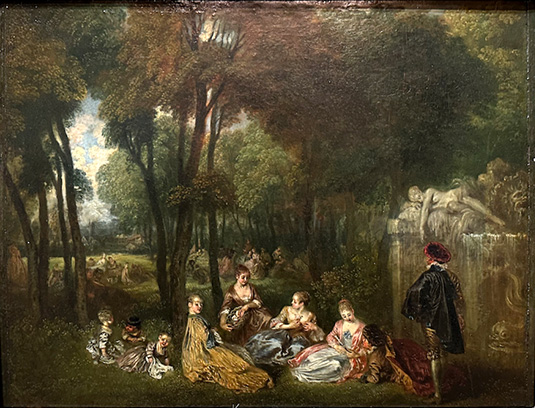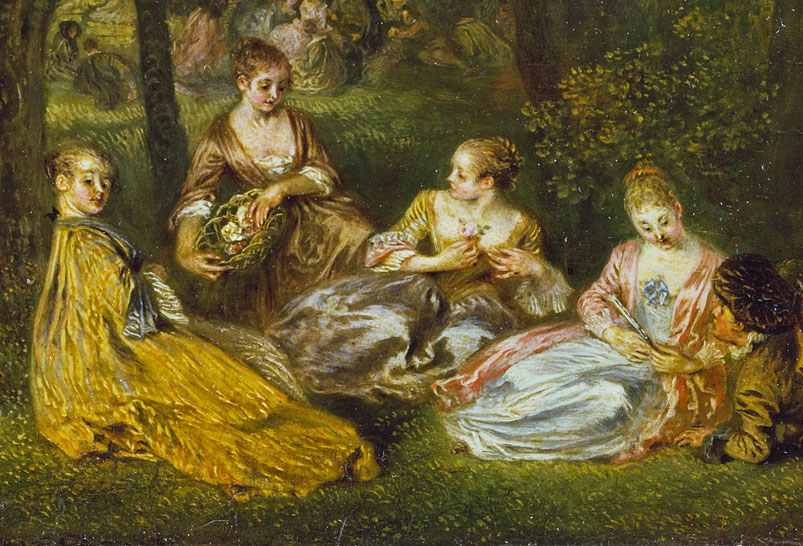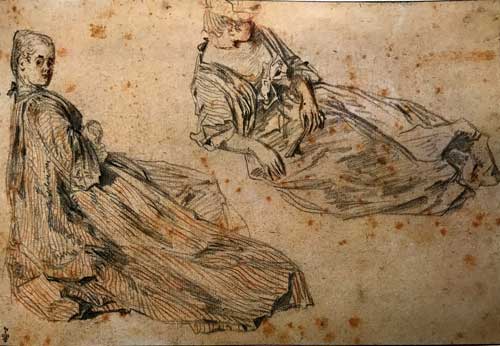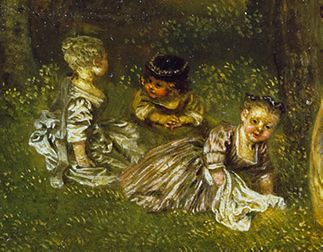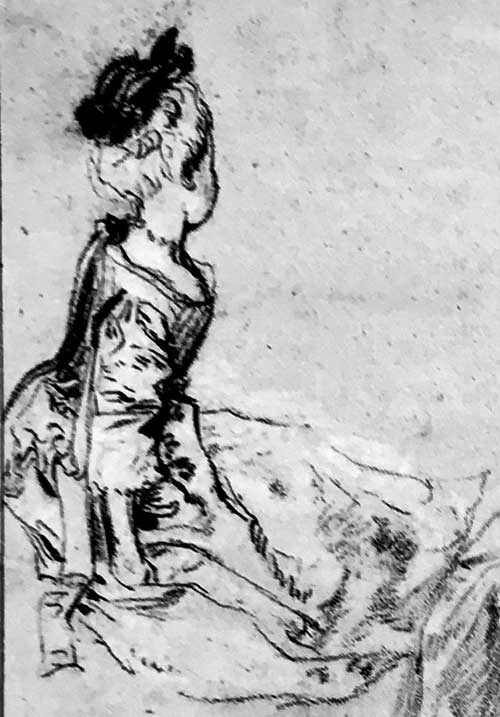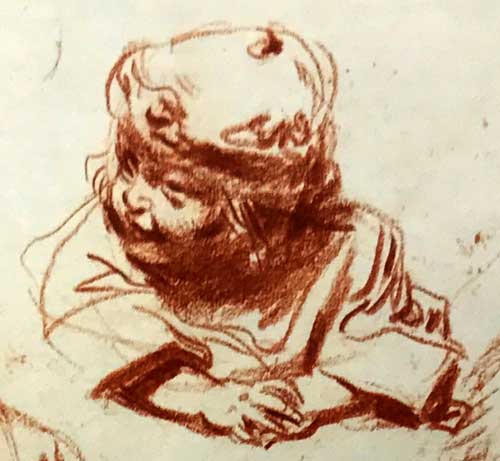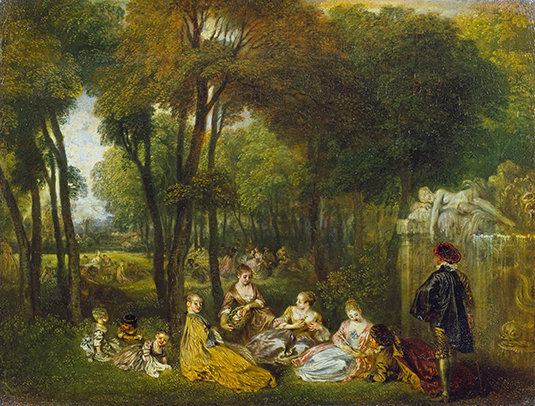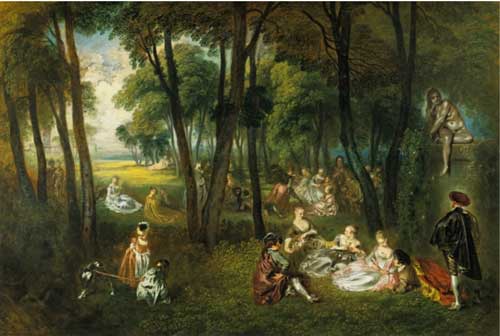
- Home Page
- Accepted
Paintings & Copies - Doubtful
Attributions - Doubtful Textual References
- Alternative
Titles - Collectors &
Museums - Bibliography
- Search Abecedario
- Watteau &
His Circle
Les Champs Élisées
Entered August 2017; revised December 2024
London, Wallace Collection, inv. P389
Oil on walnut(?) panel
31.4 x 40.6 cm; with lateral pine strips bringing the aggregate to 33.1 x 42.6
ALTERNATIVE TITLES
Les Champs-Elysées
Evening Amusement
Garden Party in the Champs Élysées
RELATED PRINTS
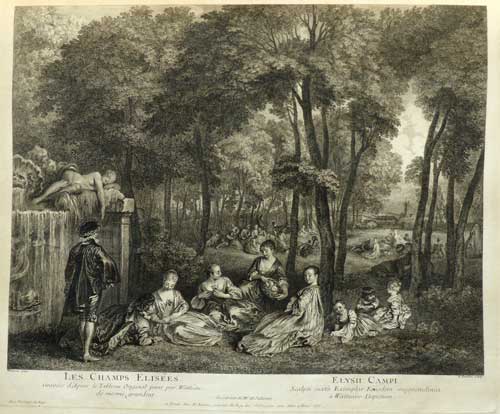
Nicolas Henri Tardieu after Watteau, Les Champs Élisées, 1727, engraving.
Watteau’s painting Les Champs Élisées was engraved by Nicolas Henri Tardieu, and was announced for sale in the December 1727 issue of Mercure (p. 2677).
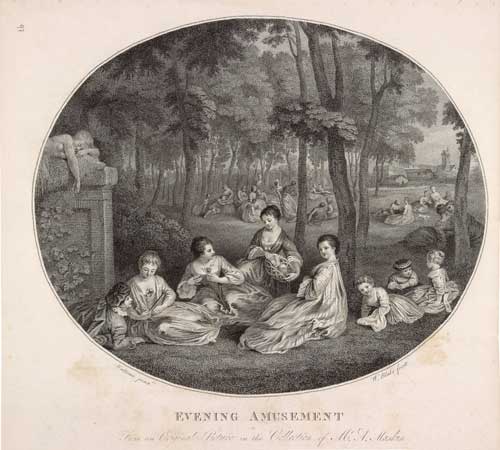
William Blake after Watteau, Evening Amusement, 1782, engraving.
The central portion of Watteau’s Les Champs Élisées was engraved by William Blake in an oval format, and in the opposite direction of the original picture. In addition to Blake’s name, the print is captioned “EVENING AMUSEMENT / From an Original Picture in the Collection of Mr.. A.. Maskins” and also “Pubd.. as the Act directs August 21.. 1782, by T.. Macklin, No 19 Fleet Street.” This was one of Blake’s first projects after his apprenticeship, and it was a very early moment as well in the career of the print publisher Thomas Macklin (1752/53–1800). Indeed, he had only started his business in 1779, helped by an inheritance of £20,000.
Although the print repeats most of Watteau’s composition, it omits the man standing before the fountain, a portion of the fountain itself, and some of the landscape on the opposite side. The oval frame cuts the composition insensitively. When Blake executed this engraving in 1782, Watteau’s original painting was still in Paris, in the collection of the duc de Chabot. Until now most scholars have presumed that Blake was copying an oval painted version of Les Champs Elysées, onethat was in the Maskin collection as is proclaimed in the inscription beneath the print. Blake also executed a pendant print in oval format after Watteau’s Le Rendez-vous de chasse; it too was supposed to be after a painting in Maskin’s collection. However, it is more probable that Blake was working from the Jullienne prints. The notion that such Watteau paintings were then in London was probably just commercial fiction, especially as there are no traces of such oval paintings in earlier or later English collections.
PROVENANCE
Paris, collection of Jean de Jullienne (1686-1766; director of a tapestry factory) by 1727; his ownership is cited in the caption on Tardieu’s engraving: “du Cabinet de Mr de Jullienne.”
Paris, collection of Jean-Baptiste de la Curne de Sainte-Palaye (1697-1781; historian and lexicographer). This provenance, not previously noted, stems from an annotation in a copy of the 1787 duc de Chabot sale in the Watson Library, Metropolitan Museum of Art, New York, apropos of Les Champs Elisées: “a été dans le cabinet de Mr la Curne de St palaye.”
Paris, collection of Augustin Blondel de Gagny (1696-1776; general treasurer of the Caisse des Amortissements and supervisor of the Menus-Plaisirs du Roi). Cited there by 1752 [see Dezallier d’Argenville, Voyage pittoresque de Paris, 1752, 232, but not the 1757 or 1765 editions).
His sale, Paris, December 10, 1776-January 22, 1777, lot 222: “[ANTOINE WATTEAU] Les Champs Elisés: on Remarque sur le premier plan quatre femmes assises, trois enfants qui jouent, un homme couché à terre & habillé en Mézetin, un autre homme debout proche d’une fontaine, dans l’éloignement nombre de petites figures sous des arbres.
Ce tableau intéressant de composition, est d’une touche savante, d’un fort coloris agréable & d’une très belle conservation; il est peint sur bois, & porte 1 pied de haut, sur 1 pied 3 pouces de large.”
Sold for 6,505 livres. According to several annotated copies of the sale catalogue, the buyer was “d’Azincourt” or Chariot for Dazincourt.Paris, collection of Bathélémy Augustin Blondel d’Azincourt (1719-1794; military officer, husband of an heiress). His sale, Paris, February 10-17, 1783, lot 34: “ANTOINE WATTEAU. . . . Les Champs Elisés: ce Tableau connu sous ce titre, offre un paysage agréable, dans lequel se voyent différens grouppes de figures, ajustées suivant le costume de ce charmant Artiste; sur le devant sont quatre jeunes Femmes qui tiennent des fleurs, & un jeune Homme vêtu en Mézetin, couché près d’elles & leur parlant; plus loin on voit un autre Homme debout près d’une fontaine, & trois enfans. Et sous les arbres, sont encore diverses petites figures. Hauteur 12 pouces, largeur 15. B. no. 222, du Catalogue de Gagny.
Ce superbe Tableau est aujourd’hui regardé comme l’ouvrage le plus parfait de cet aimable Peintre; on sait qu’il fut dans son genre le Rubens de notre école: on retrouve ici tout à la fois sa touche la plus vigoureuse & la plus spirituelle, les graces de ses plus agréables compositions, & cet ensemble flatteur & séduisant qui caractérise vraiement les chefs-d’oeuvres.” Sold for 8,000 livres to “de Vaudreuille” according to an annotated copy of the catalogue in the Frick Art Reference Library, New York.Paris, collection of Joseph Hyacinthe François de Paule de Rigaud, comte de Vaudreuil (1740-1817). No record of Les Champs Élisées can be found in the Vaudreuil collection of paintings, which was sold on November 26, 1787. Lot 196-97 in the Vaudreuil sale was Les Divertissements Champêtres, the larger version of Les Champs Élisées.
Paris, collection of Louis Antoine de Rohan-Chabot, duc de Chabot (1733-1807). His sale, Paris, December 10, 1787, lot 62: “ANTOINE VATTEAU . . . Les Champs Elisées. Il se trouve gravé dans son oeuvre. Ce Tableau offre un paysage frais, où se trouvent différens grouppes de figures ajustées, suivant le costume que Vatteau avoit adopté; sur le devant, quatre jeunes femmes couchées à terre, tiennent des fleurs; près d’elles, un jeune hommes [sic] vêtu en Mézetin, paroît leur parler; plus loin on voit un homme & trois enfans debout, près d’une fontaine: les plans éloignés offrent encore différens grouppes de petites figures. Ce superbe Tableau a réuni tous les suffrages, dans la Collection de M. Blondel de Gagny, où il a été vendu 6505 liv. sous le no. 222; & 8000 liv. dans la vente de M. d’Azincourt, sous le no. 34 de son Catalogue. Hauteur 12 pouces, largeur 15. B.” According to annotated copies of the sale catalogue in the Frick Art Reference Library and the Watson Library, Metropolitan Museum of Art, both in New York, the picture sold for 4,850 livres to Dulac.
Paris, collection of Antoine Charles Dulac.
London, collection of Charles Auguste Louis Joseph, duc de Morny; cited in his collection by Hédouin, “Watteau” (1845), cat. 23; his sale, London, Phillips, June 20-21, 1848, lot 77: “WATTEAU (A.) / Les Champs Elysées, the smaller picture. Panel, 16½ in. by 12½ in.” Bought by the 4th Marquess of Hertford for 23,823 francs (£945).
London, collection of Richard Seymour-Conway, 4th Marquess of Hertford (1800-1870); bequeathed to his illegitimate son and secretary, Sir Richard Wallace (1818-1890).
EXHIBITIONS
London, Royal Academy, Old Masters (1889), cat. 93 (by Watteau, Garden Party in the Champs Élysées, lent by Sir Richard Wallace).
SELECT BIBLIOGRAPHY
Hédouin, “Watteau” (1845), cat. 25.
Hédouin, Mosaïque (1856), cat. 23.
Waagen, Treasures of Art in Great Britain (1854-57), 2: 156; 4: 83.
Goncourt, Catalogue raisonné (1875), cat. 116.
Zimmerman, Watteau (1912), no. 77.
Dacier, Vuaflart, and Hérold, Jean de Jullienne et les graveurs (1921-29), cat. 133.
Réau, “Watteau” (1928), cat. 158.
Parker, Drawings of Watteau (1931), 36-40.
Adhémar, Watteau (1950), cat. 183.
Mathey, Watteau, peintures réapparues (1959), 69.
Mirimonde, “Statues et emblèmes” (1962), 16.
London, Wallace Collection, Pictures and Drawings (1968), cat. P389.
Macchia and Montagni, L’opera completa di Watteau (1968), cat. 156.
Ferré, Watteau (1972), cat. A25.
Roland Michel, Watteau (1981), 40, 42, cat. 200.
Essick, William Blake (1983), 125-131.
Roland Michel, Watteau (1984), 89, 160, 204, 221, 229-30, 266, 270-71, 300.
Posner, Watteau (1984), 26, 111, 174, 196.
Ingamells, Wallace Collection (1989), 3: cat. P389.
Jollet, Watteau (1994), pl. 38.
Plax, Watteau and Cultural Politics (2000), 131-41.
Temperini, Watteau (2002), 73, cat. 72.
Glorieux, Watteau (2011), 303-04.
RELATED DRAWINGS
As Champs Élisées is essentially a reduced version of Divertissements champêtres, Watteau probably did not turn back to his original studies from the model but, instead, relied on his prior painting. The exception, of course, would be when he added or substituted a new figure. Thus, he repeated five of the foreground figures from Divertissements champêtres but he did not repeat the man sitting on the grass at the left side of the group. Instead, he replaced him with a seated woman who looks out at us. This new figure was one he had studied on a sheet of sketches now in the Musée Condé, Chantilly (Rosenberg and Prat 530).
Two of the children in the foreground of Les Champs Élisées can be traced to Watteau’s drawings. The young girl at the far left, seen from the side, came from a sheet in the Berlin Kupferstichkabinett (Rosenberg and Prat 182). Although Rosenberg and Prat questioned the authenticity of this and another study on the Berlin sheet, I find little to doubt. The middle child in the painting’s trio was derived from a sheet in a New York private collection (Rosenberg and Prat 440).
REMARKS
When Les Champs Élisées was sold from the de Morny collection in 1848, it was described simply as “the smaller picture.” That is because it is closely related to a substantially larger version, one that is also now at the Wallace Collection, a composition generally known as Les Divertissements champêtres or Les Amusements champêtres. (Unfortunately it was not included in Jullienne’s Oeuvre gravé and thus its title was not standardized.) Much of the figurative and landscape elements in the two works are the same except that, as always, Watteau never repeated himself exactly. For example, instead of the seated woman at the left of the foreground group, there is a man. In place of the fountain with a reclining female nude there is a statue of a nude woman seated on a high plinth. There are children at the left in both pictures, but they are not the same ones. Because Les Divertissements champêtres is substantially larger, there is space for figures in both a midground and background, whereas Les Champs Élisées has space only for background figures and these correspond to the larger work’s midground.
The puzzling question is which of the two versions came first. Did Watteau first work out his ideas in the small version and then, using it as a modello, execute the larger version? Or was it vice versa? Was Les Champs Élisées a later, reduced repetition? Scholars have generally given pride of place to Les Champs Élisées. Adhémar placed the two side by side without discussing the sequence. Réau, Macchia and Montagni, and also Roland Michel assigned priority to Les Champs Élisées. Not only did Posner propose that Les Champs Elisées was executed several years earlier than Les Divertissements champêtres, but he claimed that the later work lacks the “zest and sparkle” of the smaller work. Vogtherr is perhaps alone but not necessarily wrong in proposing that Les Divertissements champêtres was executed first. He noted that “In Les Champs Elisées the tiny background figures are sketched without any hesitation . . . It seems much more likely that here Watteau referred to figures which he had already developed on a larger scale. In general, Les Champs Elisées shows virtually no pentmenti, which could mean that it is a second version, many compositional questions having been solved in the first.” Conversely, there are pentimenti in the background figures of Les Divertissements champêtres, which by the same reasoning would signify that it was indeed the first version.
One of the few points of agreement among the critics is that both paintings were executed late in Watteau’s career. As always, though, few agree about the specific date to assign them. Adhémar dated both Les Champs Élisées and its larger rival to the last months of 1716. Macchia and Montagni proposed 1717 for Les Champs Elisées, and 1718 for Les Divertissements champêtres, while Roland Michel dated the former to 1716 and the latter to 1718. Réau positioned the two paintings together after the Louvre Pèlerinage (mid-1717) and before L’Amour paisible (1719-20). Temperini preferred c. 1716-18. Posner dated Les Champs Élisées to 1717 but claimed that the second painting was executed several years later, c. 1718-20. Mathey, Nemilova, and Glorieux dated Les Champs Élisées to 1718. In regard to the drawings related to Les Champs Élisées, Rosenberg has dated the latest of them to c. 1717 while Grasselli favored a slightly later dating of 1717-18, and these dates would establish a terminus post quem for the painting. Vogtherr has proposed that the Les Amusements champêtres was executed first, c. 1719-21, while Les Champs Élisées was painted later, c. 1720-21. Although c. 1717-18 for Les Champs Élisées seems to be the favored date, it remains a somewhat arbitrary conjecture.
We have slightly enlarged the provenance of this painting, but several problems and lacunae remain. The first concerns its presence in the collection of the comte de Vaudreuil. Although various copies of the 1783 Blondel d’Azincourt catalogue indicate that Vaudreuil purchased Les Champs Élisées, when the Vaudreuil sales were held in 1787, there was no sign of the painting. (Curiously, though, Vaudreuil did own Les Divertissements champêtres, its larger Doppelgänger.) The second lacuna is the period between 1787, when it was sold from the Chabot collection, and the 1840s, when the picture was in the duc de Morny’s possession.
The title of the painting is something of a double entendre. It could be understood as a reference to the Elysian fields of Greek mythology, the beautifully verdant meadows destined for heroes and the blessed in the afterlife. But for Parisians of the early eighteenth century, it had a more local and contemporary significance. The great tree-lined avenue that extended westward from the Tuileries Palace was designed by André Le Nôtre in 1667 and was known as the Grand Cours or the Grande Promenade. Extended still farther westward in 1709, this new roadway, bordered with trees and splendid houses set in gardens, became known as the Champs Elysées—the name it retains today. This is undoubtedly the point of reference for the title given to Watteau’s painting, but it should be remembered that the title was bestowed by Jean de Jullienne, not the artist.
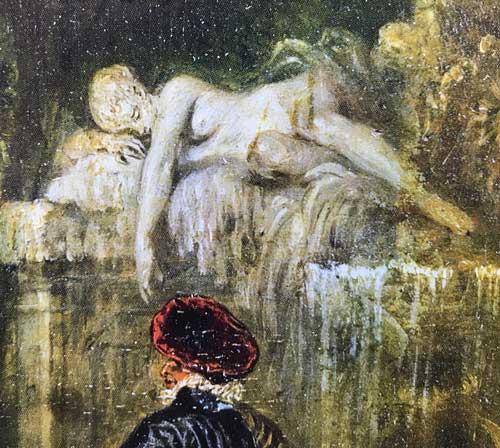
Watteau, Les Champs Élisées (detail).
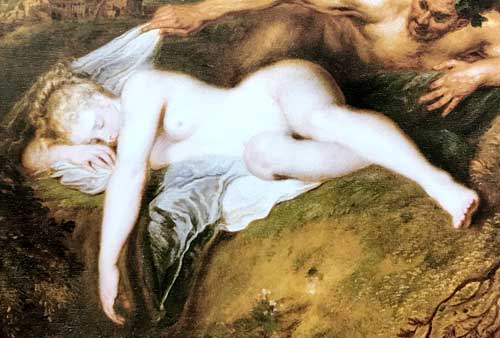
Watteau, Jupiter et Antiope (detail). Paris, Musée du Louvre.
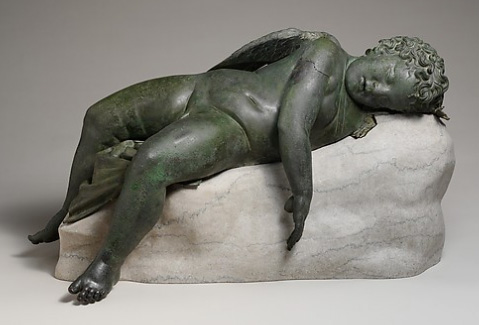
Hellenistic, Sleeping Eros, 3rd–2nd century, B.C. New York, Metropolitan Museum of Art.
Quite naturally, scholars have paid a great deal of attention to the fountain at the right of the painting and especially to the engaging nymph. Suggestively erotic, she seems less marble and more flesh. In fact, Watteau used the very same study of a sleeping woman for his painting Jupiter and Antiope, now in the Louvre. Unfortunately, the drawing that must have served for both works has not survived. The pose of this figure, with her one arm hanging down, bears a striking resemblance to a type of sleeping Eros from Antiquity. The idea could have been transmitted to Watteau through a drawing by Francisque Millet the Younger, his friend who had visited Rome and brought back such studies of Classical statuary.
The structure of the whole fountain should be considered in relation to Gilles Marie Oppenord’s designs for fountains. The two men were good friends and Watteau possessed a group of Oppenord’s fountain designs, now in the Stockholm Nationalmuseum. Whereas much discussion in the past has focused on whether the Stockholm drawings were by Watteau or Oppenord, insufficient attention has been paid to how Oppenord’s designs influenced the fountains that Watteau painted. The symmetry of the one in Les Champs Élisées, centered on a satyr’s mask and flanked at both sides by plinths, is not readily apparent because only half the fountain is shown—much as in Oppenord’s drawing. Watteau’s nymph, of course, is slimmer and more elegant than Oppenord’s robust, energetic nudes which were inspired by Bernini, but otherwise Watteau’s fountain is very much akin to the designs that Oppenord drew.
Rather than seeing Watteau’s fountain in accord with his era, modern scholars have often been tempted to read it in ways that fit a modern mentality. Mirimonde, for example, claimed that the dolphin at the base personified water and love, and the man turns his head from the nymph to look at the women as if he were surrendering to indiscreet comparisons. Plax iterated a similar idea, noting that the placement of the man below the nymph suggested the sexual thoughts he entertained while gazing at his female companions. Posner, who tried to impose sexually charged meanings on many of Watteau’s paintings, came to a somewhat opposite reading: the man is waiting for a spirit to move him to approach the group of women. The fountain nymph ”seems to point to him, and her sleep suggests his still unawakened desire.” No less eccentric, I think, is Calvin Seevold’s reading of the painting. According to him, the nymph reinforces the sardonic smile of the sculpted satyr mask, and this quiet afternoon in a park “is really a masquerade that hides one’s secret desire to be a nymph asleep, waiting for a lover to take her by surprise.” These highly personal and contradictory readings of Les Champs Élisées have little or nothing to do with the artist’s interests and intentions.
About 1850, when Waagen visited the Marquis of Hertford’s collection, he saw Les Champs Elisées, which he described as “Groups of elegant figures enjoying the pleasures of the country. This fine picture is one of the chefs-d’oeuvre of the master in size, grace of action, harmony, power of colouring, and spirited execution. From the Fesch collection.” While one would not wish to argue with Waagen’s encomium, the picture had not been in the Fesch collection; that honor belonged to Watteau’s larger version of this composition, Les Divertissements champêtres, a picture which soon thereafter did enter the marquis of Hertford’s collection.
For copies of Les Champs Élisées CLICK HERE
